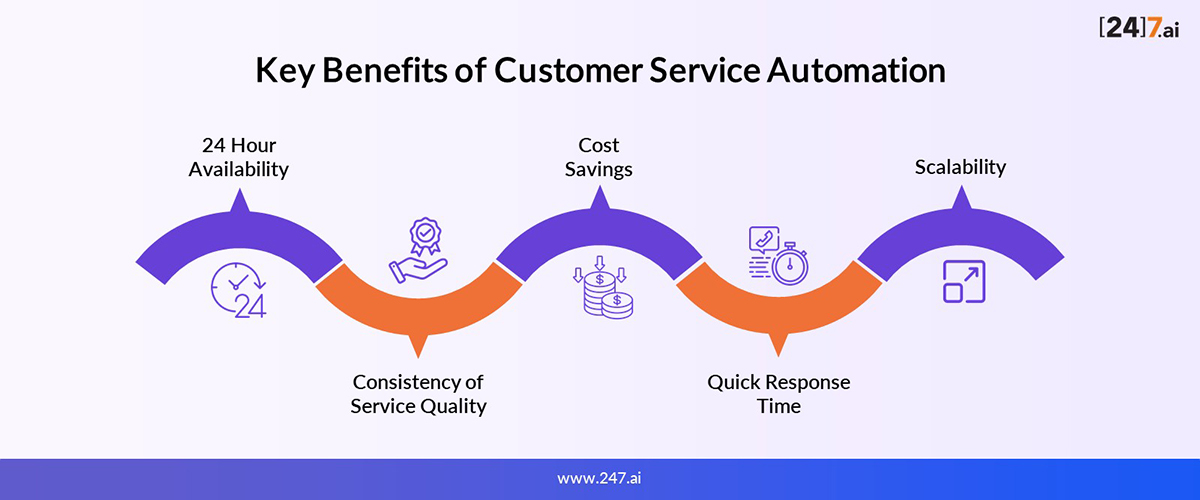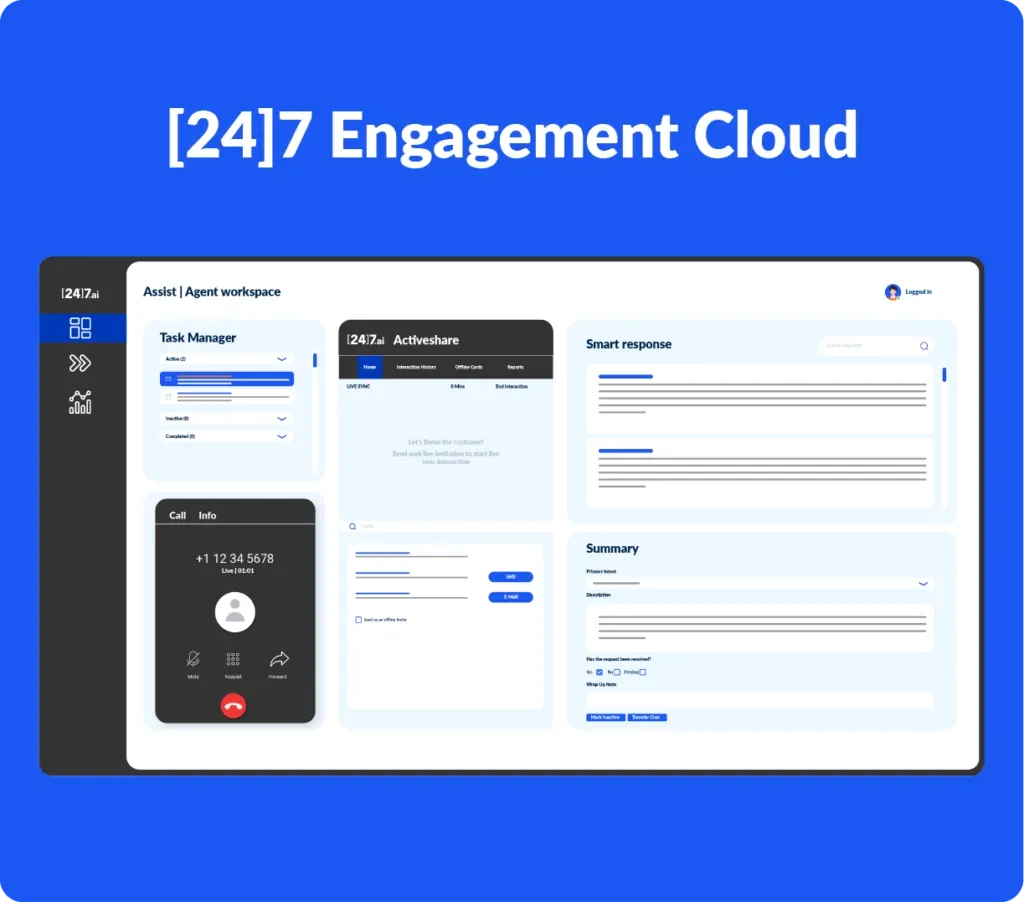Customer experience has evolved significantly over the last decade or so. We’ve gone from scripted chatbots to advanced AI agents who can address complex queries from users with incredible efficiency.
So here we are in 2025, and it’s imperative businesses become aware that automation offers more than cost savings. In fact, Gartner predicts that by 2029, agentic AI will autonomously resolve 80% of common customer service issues without human intervention, resulting in a 30% reduction in operational costs.
Automating repetitive tasks allows organizations to respond faster with consistent support. This eventually allows your manual workforce to offer high-value personalized service. This balance enhances the customer experience, while also channeling efficiencies across all service functions.

From Chatbots to AI: The Evolution of Customer Service Automation
From rule-based chatbots to sophisticated AI-powered, customer service automation has come a long way. With the virtue of this evolution, now the systems are capable of understanding the context, emotions and complexity of customer needs with ease. This progression represents a fundamental shift in how businesses handle customer interactions with less or no direct human involvement.
Most modern automation systems today harness advanced technologies such as natural language processing (NLP), machine learning (ML), robotic process automation (RPA), and predictive analytics,enabling seamless customer experiences across all touchpoints and turning simple query responses into intelligent discussions. It also delivers real conversations that are contextual and can accommodate unique customer needs or preferences in real-time.

Key Benefits of Customer Service Automation
- 24 Hour Availability: Automated systems function around the clock to ensure the customer receives the assistance they need.In fact to cater to geographies in a different time zone, this is a crucial factor. The evolved customer expects a real-time response to any queries and support.
- Consistency of Service Quality: Automation removes the human variability in service delivery. Each customer receives the same level of attention as everyone before them. The process is standardized, reducing the potential of error and providing brand consistency from one interaction to the next.
- Cost Savings: Although there is a cost associated with initial implementation, automation offers enormous cost savings over time. Accenture’s 2024 report shows 74% of organizations met or exceeded cost reduction goals with generative AI and automation, and 63% plan to increase investment by 2026.
- Quick Response Time: Automated systems review and respond to customer inquiries in seconds. This rapid engagement reduces customer wait times, increases satisfaction, and prevents abandonment. According to Forbes, automated chatbots now respond in milliseconds, handling routine tasks instantly and assuring 24/7 availability. AI-powered automation also enables 24/7 service, ensuring customers receive timely assistance regardless of time or volume spikes, further enhancing the overall customer experience.
- Scalability: During busy periods, or when there is an unexpected spike in inquiries coming through, automated systems can interact with unreal time concurrent conversations without the need for added staff or longer wait times for customers.
From Chatbots to Workflows: Unpacking Customer Service Automation
| Chatbots and Virtual Assistants | Modern chatbots have evolved far beyond simple FAQ responses. Today’s AI-powered virtual assistants understand context, maintain conversation flow, and even detect customer emotions to provide appropriate responses. |
| Interactive Voice Response (IVR) Systems | Advanced IVR systems now incorporate natural language processing, allowing customers to speak naturally rather than navigate complex menu trees. These systems route calls intelligently and even resolve simple issues without human intervention. |
| Email Automation | Intelligent email systems categorize incoming messages, auto-respond to common inquiries, and route complex issues to appropriate specialists. They can also trigger follow-up sequences based on customer behavior and interaction history. |
| Self-Service Portals | Extensive knowledge bases, community forums, and interactive troubleshooting guides enable customers to solve their problems on their own. The portals use AI to provide suggestions for relevant content and adjust search results according to customer behavior. |
| Workflow Automation | In the back end, automation handles ticket routing, escalation procedures, and internal processes. This ensures that human agents receive cases that are categorized with all relevant information and customer history. |
Vision to Execution: Strategies for Seamless Customer Service Automation
Start with High-Volume, Low-Complexity Tasks
Start automation initiatives with those repetitive questions that have clear, standardized answers. For example, requests such as order status checks, resets on passwords, base product information, and basic troubleshooting steps.
Integrate with Existing Systems
The key to successful automation is the integration with the customer relationship management (CRM), the order management, and the knowledge base application. This integration will ensure that automated responses accurately reflect the customer’s prior experience and their current status.
Design for Seamless Handoffs
Create smooth transition processes between automated systems and human agents. When automation reaches its limits, customers should be transferred to human support with full context preservation and minimal repetition.
Continuous Learning and Improvement
Implement feedback loops that allow automated systems to learn from interactions and improve over time. Regular analysis of conversation logs, customer feedback, and resolution rates help refine automation rules and responses.

The Tech Frontier: Innovations Driving Customer Service Automation in 2025
- Generative AI Integration: Large language models allow more contextual and human-like conversations. These models understand nuanced customer intents and generate accurate, helpful responses, thus improving both self-service and agent-assisted interactions. Rather than replacing agents, the platform supports them through AI copilots, real-time suggestions, and training simulations, driving more efficient, empathetic engagement.
- Predictive Analytics: Advanced analytics anticipate customer issues, behaviour, and needs, before they arise. This allows for proactive outreach and timely resolution. This shift from reactive customer service delivery to predictive is a significant development in customer experience strategy.
- Omnichannel Orchestration: Modern automation platforms keep a conversation context across multiple channels such as web chat, social, email, phone, etc. Omnichannel refers to channels presenting a cohesive experience regardless of which channel the customer uses to interact.
- Emotional Intelligence: AI systems are getting better at creating intelligent conversational experiences and also identifying customer sentiment and emotional states. So you can respond more empathetic to customer needs and also escalate a conversation if you see signs of frustration or dissatisfaction from the customer.
Best Practices for Success
| Maintain Human Monitoring | While automation handles routine tasks, human agents should monitor system performance, review edge cases, and provide oversight for complex situations. The goal is human-AI collaboration, not complete replacement. |
| Personalization at Scale | Use customer data to personalize automated interactions. Reference previous purchases, acknowledge loyalty status, and tailor responses based on customer preferences and history. |
| Transparent Communication | Be clear about when customers are interacting with automated systems versus humans. Transparency builds trust and sets appropriate expectations for the interaction. |
| Regular Performance Tracking | Track key metrics, including resolution rates, customer satisfaction scores, escalation frequency, and response accuracy. Use this data to continuously optimize automation rules and improve system performance. |

Defining Success in Customer Service Automation
Defining success relates to evaluating operational metrics and customer experience metrics. Examples of key performance indicators (KPIs) are first contact resolution rate, average handling time, customer satisfaction scores and percentage of issues resolved without human intervention.
Customer feedback is key to automation effectiveness. Regular surveys and sentiment analysis will show where automation is winning and where human touch is still required.
[24]7.ai: The Future of CX Through Intelligent Automation
Customer service is advancing, driven by AI, voice recognition, and Natural Language Understanding (NLU). However, the future belongs to organizations that recognize automation not as a replacement, but as a powerful enhancement to human expertise.
With [24]7.ai’s Customerverse, intelligent automation creates experiences that anticipate needs, assist effortlessly, escalate when necessary, and disengage thoughtfully – all this across channels and in real time. It combines the efficiency of automation with the empathy, creativity, and contextual intelligence of human agents, empowered by generative AI and smart agent assist tools.
This results in customer experiences that are faster, more personalized, and more human.
Ready to elevate your CX with intelligent automation?
Explore what [24]7.ai Customerverse can do for you.
Frequently Asked Questions
Automation feels cold without care. Use natural language, empathy, context awareness, and human handoffs to keep customer interactions warm.
Companies now automate sentiment analysis, proactive outreach, follow-ups, and real-time cross-selling without human involvement.
Absolutely! When automation provides fast, consistent support that respects customer time, it builds trust and strengthens loyalty.
AI systems use controlled vocabularies, safety filters, and brand-specific training to maintain compliance and consistent tone.
It certainly is. Automation captures customer interaction patterns, revealing insights that improve products and service experiences.



